Preserving the Magic of Madagascar
Air Date: Week of November 25, 2005
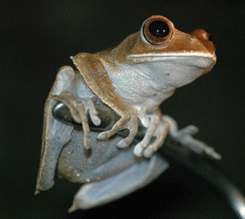
(Photo: Daniel Grossman)
PART 1: This week we present a special two-
part report on Madagascar. This island nation off the southeast coast of Africa possesses the most numerous and rarest of animal and plant species on the planet. Producer Daniel Grossman visited the island to assess the conservation efforts underway to preserve Madagascar's unique ecosystem which is under intense pressure from deforestation.
PART 2: Our story on efforts to protect
Madagascar's rich flora and fauna continues with a look at how scientists and farmers are working to develop new agricultural methods that allow farmers to make a living without cutting down any more of the island's forests. Daniel Grossman reports.
Transcript
CURWOOD: It’s Living on Earth. I’m Steve Curwood. The island nation of Madagascar, off the south east coast of Africa, is famous for two things: It is home to an astounding range of plants and animals found nowhere else in the world. And it has become famous for the rapid degradation of its habitats. Now, even though Madagascar has already lost most of its original forest cover, it is still rich in biological diversity, and preserving what’s left has become a top priority for international conservation organizations. Dan Grossman has our report.
[RAINFOREST SOUNDS CONTINUE]
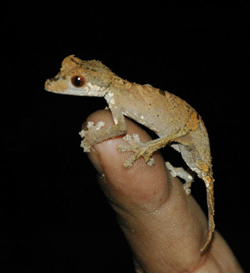
A gecko. (Photo: Daniel Grossman)
According to Stuart Pim, a tropical forest specialist at Duke University, primeval rain forests occupy only about five percent of Earth’s land, yet contain around half of all terrestrial species. They’re being cut today at a furious rate. Every second about one acre of tropical forest is being cleared for grazing, agriculture, or other purposes. Every month a combined area of rainforest about the size of Connecticut is cleared somewhere.
It’s easy to imagine the major villains as short-sighted ranchers, corrupt politicians and unscrupulous timber companies. But in Madagascar, most enemies of the forest are of a different breed. In a country where a third of the people are undernourished, the forest’s foes are the poorest of the poor. Sometimes on the verge of starvation, they’re just scraping by.
Primate researcher Alison Jolly writes about one such man in her book “A World Like Our Own: Man and Nature in Madagascar.” She found him carrying his indispensable coup-coup ax.
JOLLY (READING): With a coup-coup over his shoulder, and a bridled dog behind him, Jean d’Armand strode up the mountain path as though he wore Paul Bunyan’s boots instead of cracked calluses upon his heels. Jean is the rainforest’s executioner. He’s the last frontiersman in a world that has no wilderness to spare. In defiance of Malagash law, and all principals of conservation, he still tackles the virgin forest with his coup-coup. He brings down rosewood, towering white rami trees, and hinsi, the cabinet-maker’s prize, with its crimson heart. These rainforest hardwoods are too dense even to float and must rot for one or two years before Jean can burn their trunks to enlarge his little homestead clearing.
GROSSMAN: These trees release so much water vapor through their leaves, they alter the weather. In their great green canopies live whole communities of plants and animals, including voluptuous orchids, blankets of moss, vines and tree-dwelling rodents. For the forest, such trees are the cornerstone of life. To a forest executioner with a family to feed, they’re a stack of valuable lumber.
A single hole in the canopy severs threads in the living fabric of the forest, and takes years to heal. As more trees are cut, the fabric unravels irreversibly. That’s what’s happening to Madagascar’s virgin, or primary, forest. Only about 10 percent of it remains intact. Biologists and conservationists around the world are watching Madagascar’s forests anxiously, concerned about the fate of its distinctive wildlife. Alison Jolly says Madagascar’s forests may look like any other at first glance, but up close they’re very different.
JOLLY: Madagascar’s a kind of science fiction world. You know, every science fiction writer tries the tale of alternate worlds. What would happen if time broke its banks and came to the present down a different channel? Well, Madagascar is just like that. Eighty or ninety percent of all its plants and animals are unique. The species are unique to Madagascar. You go there and you look and you say, “Oh, that’s a nut hatch.” Uh-uh. It’s a coral-billed vanga. It’s an animal, a bird whose whole family only lives on Madagascar. You look and you say, “Oh, that’s Arizona. That’s a cactus.” Oops. No. It isn’t quite right. It’s 20 foot tall and it sticks up like a giant hand against the sky and it has thorns all down it. But it’s got wood inside. It isn’t a cactus.
GROSSMAN: Perhaps the most famous of Madagascar’s animals is a primitive group of primates called lemurs. Dr Jolly, who’s a lemur expert, says they don’t even look like anything elsewhere.
JOLLY: You look at lemurs and you think, "Wait a minute. That’s not a cat, and that’s not a squirrel and it’s got hands with fingernails and big round eyes that look right at you. So what is it? And they live in societies that are like ours but with real twists, like complete female dominance".
GROSSMAN: Madagascar is special not just because most of what lives there lives only there. It’s also because of the bewildering variety of what’s there. Take plants. There are 12-16 thousand species of plants native to Madagascar.
MITTERMEIER: By comparison, all of North America, north of Mexico, has about 18,000.
GROSSMAN: Primate expert Russell Mittermeier is president of Conservation International, one of the world’s leading non-governmental advocates for tropical forest protection. He says the island is unusually rich in many animals, too, including snakes and chameleons, among the reptiles.
MITTERMEIER: The estimates run from about 340 to as many as 380 species of reptiles in this island that is a little bit larger than California and a little smaller than Texas. In all of the United States north of Mexico you’ve got about 300 reptile species. It looks like we are going to go as high as 300 amphibian species in Madagascar. This is more than all of the United States and Canada put together.
GROSSMAN: But Madagascar’s phenomenal fauna is not what it used to be.
[SOUND OF DIG SITE; SHOVELS SCRAPING; “Where’d the brush go?”]
GROSSMAN: Biologist David Burney squats on the balls of his feet on the floor of a pit the size and shape of a grave.
[BURNEY TALKING TO COLLEAGUES AT DIG SITE; “It’s not tortoise.”]
GROSSMAN: Hands caked in mud, face bronzed by the relentless sun, Burney breaks the compacted soil with a smack of a geologist’s pointed hammer.
BURNEY: The largest hole that I’ve dug like this, with the occasional help of a small pick but mostly just with my bare hands, so I don’t break up stuff and scratch it, is about 60 feet long and 20 feet wide and 20 feet deep. It’s on the island of Kawaii. I think we’ve probably, in that one site, done this kind of stuff to now, total of about 200 cubic meters. So, you know, I must like doing this. I don’t’ seem to mind it anyway.
GROSSMAN: For more than two decades, Burney has been researching what Madagascar was like before it was peopled. He believes learning the fate of wildlife in the past will help to anticipate – or, perhaps, to shape – the fortunes of wildlife in the future. Madagascar’s original settlers, probably Indonesian people sailing outrigger canoes, arrived here about 2,000 years ago. Burney says they must have been astounded by the wildlife they discovered, including the largest bird that ever lived, the elephant bird.
BURNEY: Elephant birds were probably up to 1,000 pounds, 500 kilos, and stood ten feet tall. Over three meters. Try to imagine an ostrich multiplied by three or four.
GROSSMAN: This colossal flightless fowl was among dozens of oversized creatures, known as megafauna, unique to Madagascar. The remarkable menagerie included a gorilla-size lemur, a coffee table-size tortoise, and a cow-size, hippopotamus-like creature.
BURNEY: So we had a really diverse landscape here. A lot of different kinds of mammals. A lot of diversity of primates. Not like any place else on Earth. And now it seems to all be gone.
GROSSMAN: Today these bizarre giants are extinct. Aside from the crocodile, the largest native animal now is not much bigger than an overfed pussycat. Burney says humans almost certainly starred in this murder mystery, though the “murder weapon” and the exact scene of the crime are unknown. Was it hunting in marshes? Logging in forests? Burning in savannas? Whatever it was that humans did to the megafauna, the scientist says his gut tells him the purge is not over yet.
BURNEY: My suspicion is that Madagascar is still in an extinction event. It’s simply affecting now smaller animals. And perhaps eventually even some plants.
GROSSMAN: Burney believes the biggest breeds went first because large animals are generally more affected by forest clearing, hunting, and the like, than small ones. They need more territory and they generally breed—and thus recover from disturbance—more slowly. Hunters find them easier to spot and more worthwhile to catch. Today, Madagascar’s once-continuous forest canopy has turned into an archipelago of tiny embattled wildlife strongholds in a sea of farmland and pastures. Now even the smallest creatures are at risk.
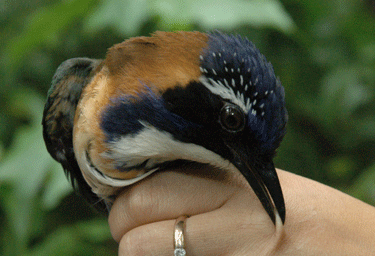
The pitta-like ground roller dwells almost exclusively on the forest floor. (Photo: Daniel Grossman)
FREUDENBERGER: What we see today is the last remaining sliver of the vast primary forest that used to cover Madagascar.
GROSSMAN: Agriculture expert Mark Freudenberger says Madagascar’s rural poor are trapped in an ill-fated cycle of forest destruction. In much of this country, the only new land available for farming is primary forest. So when farmland becomes exhausted and unproductive, and when new families need new plots, people are forced to clear virgin forest tracts. Bigger trees are sold as lumber and firewood. The rest is simply burned.
The soils are thin and poor, but the canopies are nutrient rich. Converted to ash, the burned vegetation makes land highly productive at first. In a matter of years, the nutrients are expended and these plots become useless. The farmer’s dream turns into a conservationist’s nightmare as hungry families cut fresh parcels of virgin trees.
FREUDENBERGER: The processes of slash and burn, or shifting cultivation, are creating a conversion of natural forests into barren wastelands.
GROSSMAN: Mark Freudenberger runs a project to find less destructive practices with funds from USAID, the U.S. Agency for International Development. Madagascar is losing rain forest at between one and a half and five percent a year according to a 2002 article in the Journal of Science. That’s several times higher than the global average for rainforest clearing. At these rates, half of Madagascar’s remaining forest could be gone in the time it takes to raise a child, and the island’s native fauna will have almost nowhere to live.
In a place where evolution’s engines seem to have been turbocharged, even a tiny forest parcel sometimes contains distinct species found nowhere else in Madagascar, much less anywhere else on Earth. In the late 1980s, biologist Steve Goodman, a legendary expert on the birds and mammals of Madagascar, discovered firsthand how clearing a single forest tract can doom an entire species.
GOODMAN: We surveyed a very interesting forest that I don’t think anyone had ever been to before us.
GROSSMAN: The survey team had several wildlife specialists, including a herpetologist to study reptiles and amphibians.
GOODMAN: And the herpetologist on that trip captured at least two animals that were new to science.
GROSSMAN: That’s two reptiles that had never even been heard of before. A couple of years after the discoveries, Goodman returned to the site to snap some photographs to illustrate some of several papers about the new species.
GOODMAN: We went back to the place and the forest had disappeared. These papers were associated with the description of species new to science, but probably it was a description of extinct organisms. In the course of three years, an important block of forest that had unique organisms disappeared.
GROSSMAN: What happened to it?
GOODMAN: It was cut for slash and burn agriculture.
GROSSMAN: About three percent of Madagascar’s remaining primary forest is under protection in parks. The country’s president has pledged to triple that number by 2009. Achieving this goal will be tough, experts say. But even if it is accomplished, most of the country’s forests remain at risk.
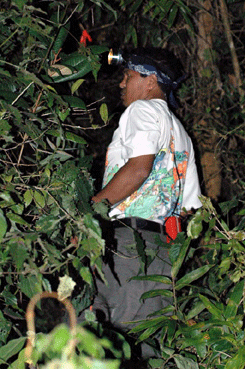
Achille looking for chameleons at night. (Photo: Daniel Grossman)
[SOUND OF RASELIMANANA INSTALLING TRAPS; FOOTSTEPS THROUGH THE FOREST]
GROSSMAN: Herpetologist Achille – who, like many Malagasy, usually goes by his first name – has dug a long line of holes in the soil of a rainforest. It took him two bone-rattling days by jeep and four hours on foot to get here, a remote, wooded valley in northeastern Madagascar. The earth underfoot here is springy. The air has the sweet smell of freshly cut grass. Lemurs bark out calls from treetops.
[LEMURS HOWLING IN THE DISTANCE]
GROSSMAN: Achille is one of four biologists, each with a different specialty, setting traps and making observations here. He says he’s been interested in snakes and frogs since childhood.
RASELIMANANA: When I was a kid I caught grasshopper. With this grasshopper I [inaudible] and to catch frog. And then I used this frog to catch snake. And then I tried to catch the snake and then push them to vomit the frog. And sometimes it is still alive. So, even when I was a kid I already love animals.
GROSSMAN: Decades and a doctorate in biology later, the researcher now gets paid to catch the slimy and slithering.
RASELIMANANA: What we would like to do is do a biological inventory. We would like to know what kind of animals live in this area, and what kind of distribution.
GROSSMAN: The Malagasy scientist shoves a plastic bucket into each hole, flush with the ground. A waist-high fence of plastic nailed to wooden stakes will funnel snake-like skinks, insects, rodents and other small animals into the containers. Once inside, the animals will be kept from escaping by the bucket’s slick sides.
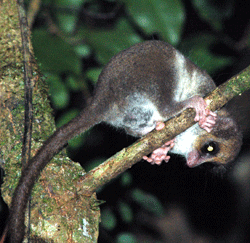
One of the rarest mammals in the world—a hairy-eared dwarf lemur. (Photo: Daniel Grossman)
GROSSMAN: After two weeks at his site in northeastern Madagascar, herpetologist Achille has completed his work. The study area is no bigger than a large city park, yet the team found a wide variety of birds, bats and small insect-eating mammals. They spotted 12 species of lemurs, including a hairy-eared dwarf lemur, a raccoon-like animal with tufts of black fur sprouting from its ears. It’s considered one of the world’s rarest mammals. Achille himself found 28 species of amphibians and 33 species of reptiles, including five never before known to science: three frogs, a skink and, most exciting for him, a spiny green chameleon.
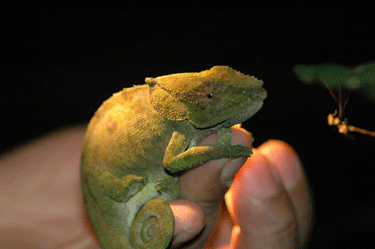
A new chameleon, discovered by Achille. (Photo: Daniel Grossman)
RASELIMANANA: To find a chameleon like this is very exciting. That’s the reason I’m always in the forest when I have time.
[FOREST SOUNDS]
[MUSIC: Carsten Nicolai & Ryiuchi Sakamoto “Duoon” from ‘Hacca Note’ (Sound Noise Music – 2003)]
CURWOOD: Just ahead: working to protect forests like these by helping farmers find less destructive ways of feeding their families. Keep listening to Living on Earth.
ANNOUNCER: Support for NPR comes from NPR stations, and: The Charles Stewart Mott Foundation, online at m-o-t-t dot org, supporting efforts to promote a just, equitable and sustainable society; The Kresge Foundation. Building the capacity of nonprofit organizations through challenge grants since 1924. On the web at k-r-e-s-g-e dot org; The Annenberg Fund for excellence in communications and education; and, The W-K Kellogg Foundation. ‘From Vision to Innovative Impact: 75 Years of Philanthropy; This is N-P-R, National Public Radio.
[MUSIC: Live Drum Music from Madagascar recorded by Daniel Grossman (2004)]
CURWOOD: It’s Living on Earth, I’m Steve Curwood. Daniel Grossman’s report on the fantastic forests of Madagascar continues now in a tiny town on the outskirts of the jungle where scientists and farmers are developing new methods to preserve the island’s ecosystem.
[A CAPELLA FOLK SINGING]
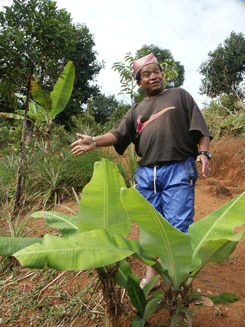
Claude stands in front of his experimental plot. (Photo: Daniel Grossman)
[SINGING]
GROSSMAN: Members of a farmers’ cooperative, they’re relaxing after nutrition workshop in a mountainous region in southern Madagascar. In a room nearby, Claude Ranaivojaona, whose wife ran the session, worries about a different sort of disaster, this one caused by people.
[SPEAKING IN MALAGAY; TRANSLATOR SPEAKING IN ENGLISH]
RANAIVOJAONA: When I was young, from here in our house we could hear the lemurs crying and making noises. Now it is very quiet. Before, the mountains were covered in forests, and, because of that, there was an abundance of water. There were a lot of springs surrounding the town, there were hundreds of small springs. But now most of those springs are dried out.
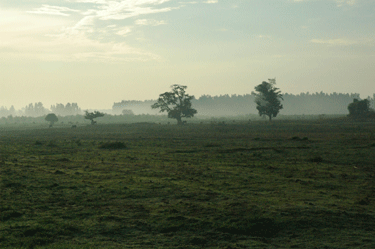
The highlands of madagascar. (Photo: Daniel Grossman)
GROSSMAN: Claude’s hamlet, Manampatrana, is in the middle of what was once a 60-mile-wide band of Madagascar’s lushest forests, running the entire length of the island’s east coast. Now, apart from the very tops of the mountains and patches here and there, nearly the whole region has been cleared for subsistence crops. In the past, many people here profited from cash crops. But one left a bitter taste in the mouths of growers such as Claude.
RANAIVOJAONA: There was a time when coffee cost 26 Ari Ari a kilo. People were able to sell coffee and buy sugar, salt, rice and even sardines.
GROSSMAN: Villagers tended saplings for years before any of the fragrant beans were ready for market. When the trees were finally mature, the efforts initially paid off. Some farmers even replaced their thatch roofs with tin for the first time. Then the coffee market collapsed. A decade later coffee prices are still depressed, and many of the tin roofs here are rusting. Despite recent signs of a recovery, Claude says growing coffee is too risky for most people here.
RANAIVOJAONA: Today it’s one price. In 15 days it’s another. A month later it’s another. And, because of this constant fluctuation in price, they are no longer secure, and so they constantly go to the forest to find quick money. Because through the forest you can always get quick money to survive day-by-day.
GROSSMAN: Claude hopes to save the remaining forest by making cultivated plots more profitable and productive for longer.
[WATERFALL FLOWING; FOOTFALLS]
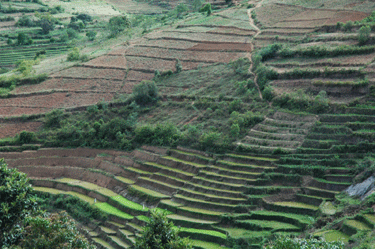
Rice paddies of Madgascar. (Photo: Daniel Grossman)
GROSSMAN: Wearing a brimless straw hat in the gathering heat of the day, the Malagasy farmer walks briskly up a precipitous footpath. He passes men and women tending plots as steeply sloped as a Swiss chalet’s roof. Unlike rice paddies on the valley bottom, when these fields are planted with crops such as rice they’re at risk of losing their soil to erosion from tropical downpours.
RANAIVOJAONA: So what we see here is my plot, where I’ve planted pineapple and banana.
GROSSMAN: Claude stops and motions majestically to a small plot of waist-high plants. In contrast to hillside rice and other annual crops planted on most of this valley’s slopes, perennial crops like these don’t get pulled up every year.
RANAIVOJAONA: It is better to plant fruit. Fruit trees. Because fruit trees, the fruit is above ground and can be harvested above ground. If you plant plants that are tubers, and whose produce is under the ground, that creates holes underneath the soil which water can easily seep into, and the soil becomes more vulnerable and can be washed away.
GROSSMAN: Claude says, planted in rice, this plot’s soil would be washed away in a matter of years. Planted in tree crops like bananas, pineapples, and leeche nuts, it could keep on producing virtually forever. Income from harvesting such fruit and nut orchards will pay for staples like rice Claude would otherwise grow himself. The long-lived trees will continue earning him money, like a retirement account, even when he’s too old to work. The tiny plot is the sort of highly productive style of farming conservationists want to see more of. They say less productive practices in widespread use, like hillside rice growing, have been fostered by decisions made far away with no regard for the farmers or forests of Madagascar.
FREUDENBERGER: What we’re seeing today is the ecological impact of the incorporation of Madagascar into the international economy.
GROSSMAN: Nevertheless, USAID expert Mark Freudenberger says he thinks the global trade in agricultural products could be harnessed to help farmers to preserve the forest, rather than force them to clear it.
FREUDENBERGER: So what we’re doing now in Madagascar is focusing much more on how to create market incentives for practicing sustainable agriculture. We’re working on increasing prices. We’re working on increasing transport infrastructures so that transport costs come down, and, hence, are more of an incentive of getting agricultural produce to the markets.
GROSSMAN: Freudenberger advises farmers to plant a diverse suite of fruit and nut trees which, like an investment portfolio containing different stocks, will help them weather the financial blow when any single crop’s boom goes bust. He says Claude’s orchard is attracting the interest of other farmers, who are gradually beginning to plant their own trees. But he says the future of the little remaining rain forest in this mountainous region is still uncertain. For instance, a train line critical for shipping farm products is in danger of shutting down.
Many conservation specialists are also promoting ecotourism as a relatively benign source of desperately needed cash for Madagascar. Visits by foreigners, who pay park fees and spend money on lodging, food and supplies in villages near reserves, are on the rise. Madagascar has also recently become more open to outsiders offering assistance. Biologist Steve Goodman says for the first time in decades there’s hope for the people and wildlife of Madagascar. Goodman won a MacArthur Genius Award for his research in the country’s forests.
GROSSMAN: This is the first time in decades where there’s really hope something is actually going to happen and things are going to move in the right direction. Both for the people of Madagascar and for the unique patrimony that this island guards.
[BOYS SINGING IN ANTANANARIVO; DRUMMING]
GROSSMAN: On a pedestrian walkway in downtown Antananarivo, the Malagasy capital, two barefoot boys sing of Jesus for tips. Believers must not be tempted by material things, they chant, and he’ll return.
[SINGING CONTINUES]
GROSSMAN: The boys may not know it, but, ever since settlers arrived here, the primary source of material goods has been the forests. But now the well is almost dry. Like these chants of spiritual salvation, many biologists are warning that salvation of the forests will require a dramatic change of heart. Madagascar’s primeval habitats must no longer be seen as a source of land and lumber, but as the Ark for preserving one of evolution’s most precious gems. Lemur expert Alison Jolly:
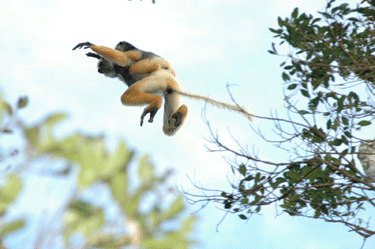
Lemur with baby on its back. (Photo: Daniel Grossman)
JOLLY: All wild species, and, above all, all wild ecosystems, are treasures. We don’t know what economic treasures there are going to be. We could guess. But they are human treasures. They are treasures of climate, of watershed, of wonder, of awe, of understanding. For understanding ourselves, our own history from the lemurs. For understanding how an ecosystem fits together. We have no idea how this will expand into some renaissance of understanding nature and understanding our place in the world. The best we can do is just keep it.
[DRUMMING AND SINGING]
GROSSMAN: For Living on Earth, this is Daniel Grossman
CURWOOD: Our story on Madagascar’s forests was originally produced for Radio Netherlands. Production assistance from Cambridge Consulting - providing management, strategy and organizational development consulting for nonprofits and foundations. To see some lovely photos of Madagascar’s wildlife - go to Living on Earth dot org and check out Daniel Grossman's award-winning website, "Fantastic Forests."
Links
“Fantastic Forests” – Daniel Grossman’s award-winning website
Living on Earth wants to hear from you!
Living on Earth
62 Calef Highway, Suite 212
Lee, NH 03861
Telephone: 617-287-4121
E-mail: comments@loe.org
Newsletter [Click here]
Donate to Living on Earth!
Living on Earth is an independent media program and relies entirely on contributions from listeners and institutions supporting public service. Please donate now to preserve an independent environmental voice.
NewsletterLiving on Earth offers a weekly delivery of the show's rundown to your mailbox. Sign up for our newsletter today!
 Sailors For The Sea: Be the change you want to sea.
Sailors For The Sea: Be the change you want to sea.
 The Grantham Foundation for the Protection of the Environment: Committed to protecting and improving the health of the global environment.
The Grantham Foundation for the Protection of the Environment: Committed to protecting and improving the health of the global environment.
 Contribute to Living on Earth and receive, as our gift to you, an archival print of one of Mark Seth Lender's extraordinary wildlife photographs. Follow the link to see Mark's current collection of photographs.
Contribute to Living on Earth and receive, as our gift to you, an archival print of one of Mark Seth Lender's extraordinary wildlife photographs. Follow the link to see Mark's current collection of photographs.
 Buy a signed copy of Mark Seth Lender's book Smeagull the Seagull & support Living on Earth
Buy a signed copy of Mark Seth Lender's book Smeagull the Seagull & support Living on Earth

